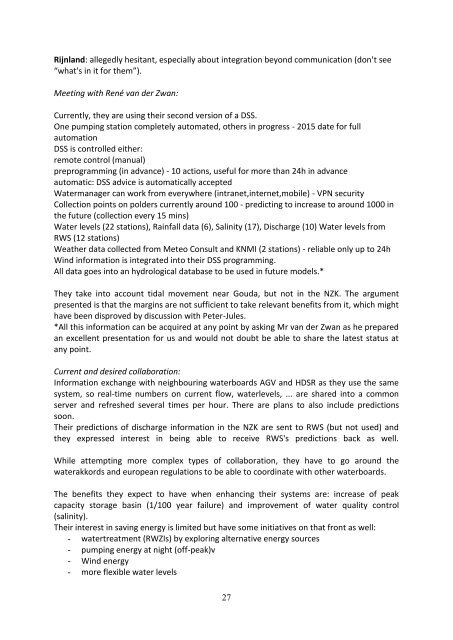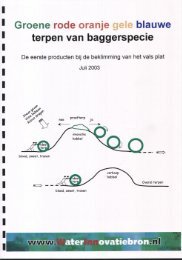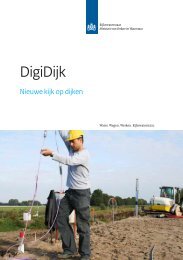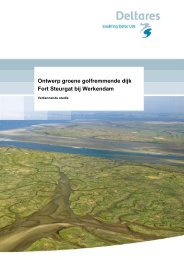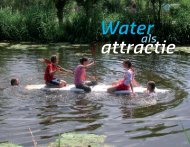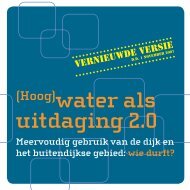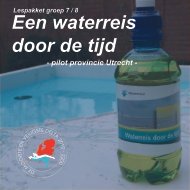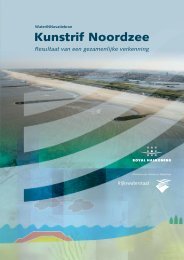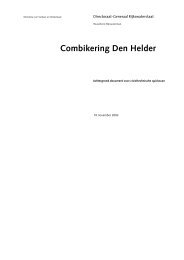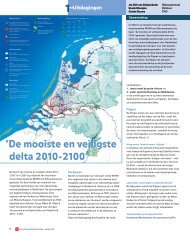Creating opportunities to adapt to climate change through innovative ...
Creating opportunities to adapt to climate change through innovative ...
Creating opportunities to adapt to climate change through innovative ...
You also want an ePaper? Increase the reach of your titles
YUMPU automatically turns print PDFs into web optimized ePapers that Google loves.
Rijnland: allegedly hesitant, especially about integration beyond communication (don't see“what's in it for them”).Meeting with René van der Zwan:Currently, they are using their second version of a DSS.One pumping station completely au<strong>to</strong>mated, others in progress - 2015 date for fullau<strong>to</strong>mationDSS is controlled either:remote control (manual)preprogramming (in advance) - 10 actions, useful for more than 24h in advanceau<strong>to</strong>matic: DSS advice is au<strong>to</strong>matically acceptedWatermanager can work from everywhere (intranet,internet,mobile) - VPN securityCollection points on polders currently around 100 - predicting <strong>to</strong> increase <strong>to</strong> around 1000 inthe future (collection every 15 mins)Water levels (22 stations), Rainfall data (6), Salinity (17), Discharge (10) Water levels fromRWS (12 stations)Weather data collected from Meteo Consult and KNMI (2 stations) - reliable only up <strong>to</strong> 24hWind information is integrated in<strong>to</strong> their DSS programming.All data goes in<strong>to</strong> an hydrological database <strong>to</strong> be used in future models.*They take in<strong>to</strong> account tidal movement near Gouda, but not in the NZK. The argumentpresented is that the margins are not sufficient <strong>to</strong> take relevant benefits from it, which mighthave been disproved by discussion with Peter-Jules.*All this information can be acquired at any point by asking Mr van der Zwan as he preparedan excellent presentation for us and would not doubt be able <strong>to</strong> share the latest status atany point.Current and desired collaboration:Information ex<strong>change</strong> with neighbouring waterboards AGV and HDSR as they use the samesystem, so real-time numbers on current flow, waterlevels, ... are shared in<strong>to</strong> a commonserver and refreshed several times per hour. There are plans <strong>to</strong> also include predictionssoon.Their predictions of discharge information in the NZK are sent <strong>to</strong> RWS (but not used) andthey expressed interest in being able <strong>to</strong> receive RWS's predictions back as well.While attempting more complex types of collaboration, they have <strong>to</strong> go around thewaterakkords and european regulations <strong>to</strong> be able <strong>to</strong> coordinate with other waterboards.The benefits they expect <strong>to</strong> have when enhancing their systems are: increase of peakcapacity s<strong>to</strong>rage basin (1/100 year failure) and improvement of water quality control(salinity).Their interest in saving energy is limited but have some initiatives on that front as well:- watertreatment (RWZIs) by exploring alternative energy sources- pumping energy at night (off-peak)v- Wind energy- more flexible water levels27


